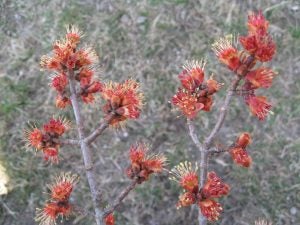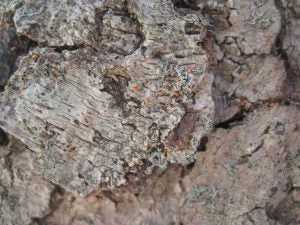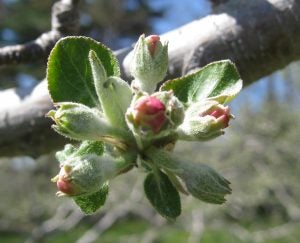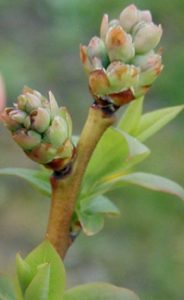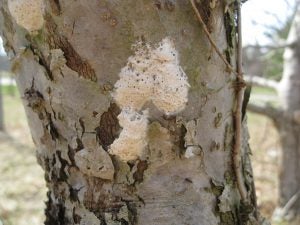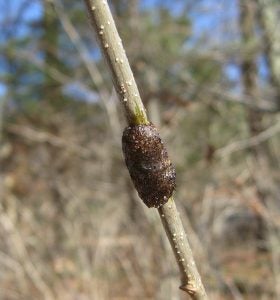URI Caterpillar Update March 18, 2018
Over the last decade, winter moth eggs started hatching anywhere from mid-March to mid-April, depending on temperature and other factors. I don’t expect eggs to hatch until after red maples start blooming and when McIntosh apple buds crack open and expose a little bit of green tissue.
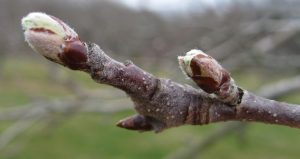
McIntosh buds at Green Tip.
Tree wraps were set up in November to monitor eggs at 10 locations in RI, one in CT and two in Massachusetts. In November and December, as female winter moths climbed trees and encountered tree wraps, female moths deposited eggs below the wraps, aggregating the eggs and making it easier to monitor now. Tree wraps have been removed at most locations, and though we have a few hundred eggs to monitor, there are many fewer eggs than past years! At two locations, no winter moth eggs were found below the tree wraps.
Winter moth eggs are orange now, but turn blue a couple of days before hatching. This trait makes it very handy for monitoring egg hatch!
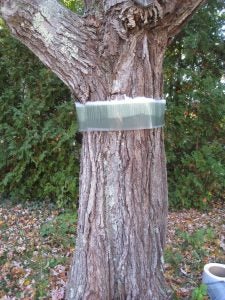
Bugbarrier Tree wrap set up in November.
Close up of small, orange winter moth eggs found below tree wrap.
Eggs are nearly impossible to find without setting up tree wrap in fall.
Winter moth populations are declining in our area. Whether or not winter moth caterpillars will need managing this spring probably depends on your situation. I don’t think landscape trees will need protecting this year – and perhaps no landscape trees needed protection from winter moth caterpillars last year. I didn’t see any trees defoliated by winter moth last year. If landscape trees do need protecting, probably the best time to spray will be late April or early May after trees leaf-out, while caterpillars are still small, and before excessive feeding damage has occurred.
For fruit (apple, pear, and blueberry) it’s hard to know what to do. For years I’ve been saying fruit growers need to spray right when eggs hatch to protect flower buds from getting infested with winter moth caterpillars. With a smaller population of winter moth caterpillars, it may not be necessary to spray when the eggs start hatching. Winter moth caterpillars will still get inside flower buds, but there are fewer caterpillars so less damage. I expect most fruit growers will still need to protect fruit from winter moth, but perhaps spraying can be delayed until apple and pear flower buds are at tight cluster or buds are starting to separate, but before flower buds open. The advantage to waiting to spray is it is difficult to time and control caterpillars when they are hatching. It is easier to get adequate control with one spray when caterpillars are larger and moving around from bud to bud.
Apple bud at Tight Cluster bud stage.
Apple buds at Bud Separation bud stages.
Blueberry buds at Tight Cluster bud stage.
Or, perhaps there are too many caterpillars and fruit crops will still need protecting when eggs first hatch.
Once eggs hatch, winter moth caterpillars wriggle into swollen buds and begin feeding. For apple & pear trees and blueberry bushes, swollen buds are primarily flower buds. Once inside buds caterpillars are protected from insecticide sprays. After a couple of weeks, as caterpillars grow and buds open, they begin to walk outside of buds and are then susceptible to insecticides again.
Dormant oil can be applied before eggs hatch, but this may not be very effective if unsprayed trees are nearby or if you cannot get complete coverage with an oil spray. Winter moth eggs are often located in bark nooks and crannies, so complete oil coverage is very difficult. When applying oil, temperature must be above freezing and remain above freezing for 24 hours after application or plant damage can occur.
Winter moth caterpillars are pretty easy to kill, provided they are not inside closed buds. Insecticide choices for caterpillars at egg hatch for fruit growers include, but are not limited to, spinosad, Imidan, Sevin, and Malathion. Spinosad product names are Delegate and Conserve (for commercial growers), Entrust (for organic, commercial growers), and Captain Jack’s Deadbug Brew (for backyard growers). Adding a dormant oil may be useful for the first spray of any of the listed insecticides.
Once buds open, B.t. kurstaki products (Bacillus thuringiensis kurstaki) such as DiPel, Thuricide (for backyard growers), and Biobit work well controlling winter moth on fruit crops and landscape trees. To protect pollinators and other beneficial insects the best choice is a B.t. product since B.t. kills only caterpillars. Spinosad will kill bees for up to 3 hours after being applied and other insecticides even longer. Do not spray spinosad or other non-B.t. products on plants in bloom. B.t. products break down in sunlight after 3-5 days so may need to be reapplied.
There are many, many fewer gypsy moth egg masses overwintering now than this time last year. I do not expect wide-spread gypsy moth problems this spring. That being said, some people have sent me pictures of several gypsy moth egg masses found on trees this winter. To protect your trees you will want to check tree leaves in mid-May for gypsy moth caterpillars.
Gypsy moth egg masses.
A bigger unknown caterpillar problem is forest tent caterpillars. This native insect has caused wide-spread defoliation in many RI communities the past two years. Since it’s a native insect there are many natural insects and diseases which attack forest tent caterpillars and usually control the population. When outbreaks occur it may take several years before the population returns to normal levels. Forest tent caterpillar populations are very difficult to predict because egg masses are relatively small and deposited high in oak trees. If you see egg masses that look like the photo you can prune them out.
Tent caterpillar egg mass.
 Home
Home Browse
Browse Close
Close Events
Events Maps
Maps Email
Email Brightspace
Brightspace eCampus
eCampus



